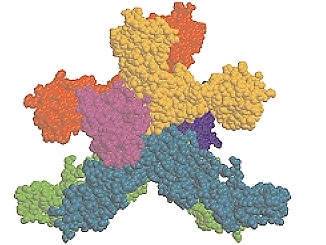|
服务
产品  
|
 Interleukin (IL)-6 Receptor
Interleukin (IL)-6 Receptor
| 名称
|
Interleukin (IL)-6 Receptor
|
| 别名
|
IL-6 RIL6R peptide
|
| 序列(单字母缩写)
|
TSLPVQDSSSVP
|
| 序列(三字母缩写)
|
{THR}{SER}{LEU}{PRO}{VAL}{GLN}{ASP}{SER}{SER}{SER}{VAL}{PRO}
|
| 基本描述
|
A soluble form of the Interleukin-6 receptor (IL-6R) was initially identified in the urine of healthy adult humans, in culture supernatants from HTLV-I positive T cell lines and in the serum of HIV-seropositive blood donors. These soluble receptors (Interleukin-6 receptor) may develop as a result of alternate splicing of the mRNA or as a result of proteolytic cleavage and release of the membrane-bound form of the receptor. Recombinant, Human IL-6 Soluble Receptor was produced by cloning the cDNA of the IL-6R and introducing a stop codon into the cDNA sequence immediately preceding the transmembrane domain. This was followed by infection of Sf 21 insect cells with recombinant baculovirus encoding the sequence for the truncated receptor. The IL-6 soluble receptor is 339 amino acid residues in length. IL-6 soluble receptor may serve to transport IL-6, protecting IL-6 from proteolysis. Alternatively, the IL-6 soluble receptor may act as an inhibitory agent to localize the activity of IL-6 or to bind IL-6 that is not bound to cell surface receptors. The bioactivity of IL-6 increases after binding to the soluble IL-6 receptor.
|
| 分子量
|
1216.300
|
| 化学式
|
C51H85N13O21
|
| 纯度
|
> 95%
|
| 存储条件
|
Stored at -20°C.
|
| 注释
|
HIV-I TAT Protein Peptide
|
| Documents
|

|
| Figures
|

|
| Reference
|
Karaduman M, et al. Leptin, soluble interleukin-6 receptor, C-reactive protein and soluble vascular cell adhesion molecule-1 levels in human coronary atherosclerotic plaque. Clin. Exp. Immunol. Mar 2006; 143(3): 452-457.
Zhang PL, et al. Increased myelinating capacity of embryonic stem cell derived oligodendrocyte precursors after treatment by interleukin-6/soluble interleukin-6 receptor fusion protein. Mol. Cell. Neurosci. Mar 2006; 31(3): 387-398.
Maggio M, et al. Correlation between testosterone and the inflammatory marker soluble interleukin-6 receptor in older men. J. Clin. Endocrinol. Metab. Jan 2006; 91(1): 345-347.
|
|
